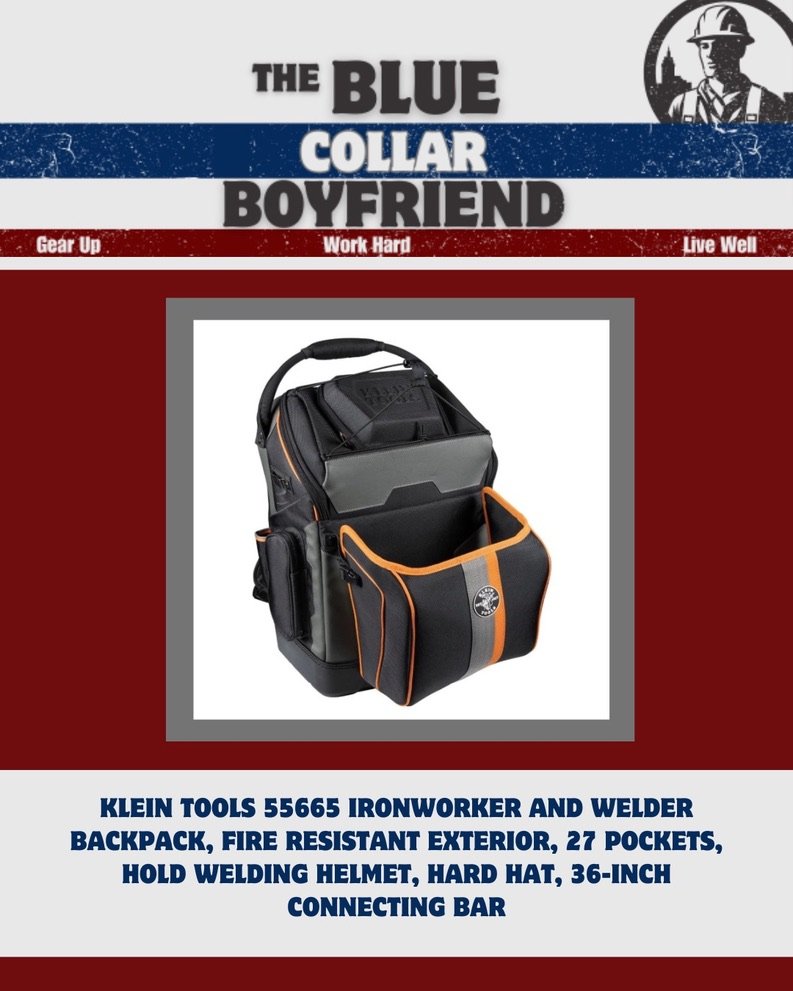
Built for the Heat: The Klein Tools Backpack Welders Actually Want
💪 Rugged by Design
Let’s start with what matters:
The body is built tough. You’ve got a molded bottom that stands up by itself — even when loaded with grinders, wrenches, and spools. The material is water-resistant, flame-resistant, and made for iron sparks and long shifts.
Inside, the backpack features a compartmentalized layout with dedicated sleeves for tools, torches, wire, and connectors. There’s even room for your lunch (or your second pair of gloves if you’re not that trusting).
🧲 Built-In Features That Welders Asked For
Here’s where it gets real:
Carabiner loop & D-rings to clip on leads, clamps, or keys
Reinforced carry handle for one-handed grabs on the go
Full zip access so you’re not fishing around elbow-deep in the dark
Wide padded straps that don’t dig when you're carrying 40 lbs of steel
This thing is more than a backpack — it's a personal welding station that moves where you do.
🛠️ Field-Tested, Welder-Approved
We’ve seen this backpack out on sites with pipefitters, boilermakers, ironworkers, and shop welders. And it holds its own in the dust, rain, sparks, and swing shifts.
One welder we talked to called it "the most organized thing I own — besides my lunchbox."
Same guy also said “I’d buy it again if someone tried to steal mine. And then I’d weld it to my locker.”
Enough said.
🔗 Get It. Load It. Weld On.
If your gear deserves more than a beat-up duffel or the floor of your truck, the Klein Tools Welder Backpack is worth it.

🏗️ Ironworkers: The Backbone of the Build
🔩 What Ironworkers Really Do
Ironworkers handle some of the heaviest, most essential work in construction. Let’s break down their key specialties:
1. Structural Ironwork
Structural ironworkers are the ones you see scaling skyscrapers or guiding steel beams into place with crane signals and nerves of steel. Their work includes:
Installing steel beams and columns
Building commercial and high-rise skeletons
Connecting massive components using bolts, rivets, or welds
Operating cranes, hoists, and rigging systems
Reading complex blueprints and load specs with precision
2. Reinforcing (Rebar) Work
Before the concrete is poured, rebar ironworkers are hard at work reinforcing the bones of the build. Their job ensures everything stays solid under pressure:
Cutting, bending, and tying rebar
Laying steel mesh inside concrete forms
Supporting bridges, highways, and high-load structures
Working with post-tension cables and pre-stressed concrete
3. Ornamental Ironwork
Ironwork isn’t just strong—it can be beautiful too. Ornamental ironworkers combine craftsmanship with durability:
Creating and installing railings, staircases, and balconies
Fabricating gates, fences, and detailed metal features
Decorative welding, grinding, and finishing techniques
Restoring historic metal elements with care and skill
4. Rigging & Welding
No steel gets set without proper rigging—and no framework holds without solid welds. These tradespeople handle:
Rigging heavy steel into position
Arc welding, plasma cutting, and metal prep
Oxy-fuel cutting for clean joints
Building temporary supports and jobsite safety systems
5. Industrial & Infrastructure Projects
Ironworkers aren’t limited to buildings—they support the nation’s biggest infrastructure projects:
Bridges, overpasses, and road systems
Power plants and renewable energy towers
Cranes, conveyors, and shipyard structures
Offshore platforms and high-stakes industrial builds
🔧 Tools of the Trade
Ironworkers don’t go into battle without serious gear. Common tools and equipment include:
Welding machines, plasma cutters, torches
Torque and spud wrenches, sleever bars
Safety harnesses, lanyards, fall arrest systems
Rigging chains, shackles, slings, and come-alongs
🎓 Training & Entry Path
Becoming an ironworker usually means entering a union apprenticeship program (3–4 years). Apprentices learn everything from welding and blueprint reading to advanced rigging and safety standards. Common certifications include:
OSHA 10 or 30
Fall protection and aerial lift training
AWS-certified welding credentials
💰 Wages & Earning Potential
Ironwork pays well—and for good reason. It’s risky, rewarding, and essential.
Hourly pay: $25–$40, with union wages often higher
Annual income: $70k–$100k+ with overtime and travel
Leadership roles: Foremen and superintendents can earn significantly more
🚧 The Road Ahead
Ironworkers are in high demand thanks to booming urban growth, aging infrastructure, and federal investment in transportation and energy projects. With safety, skill, and a solid work ethic, ironworkers have strong career longevity and advancement opportunities.
Bottom line? If you’ve got guts, grit, and a head for heights, ironwork might be your calling. These folks don’t just build buildings—they build legacies.
